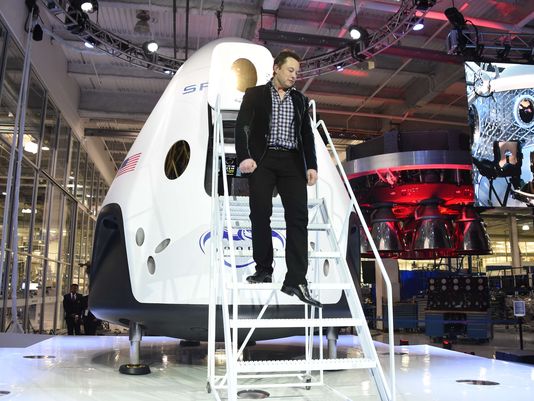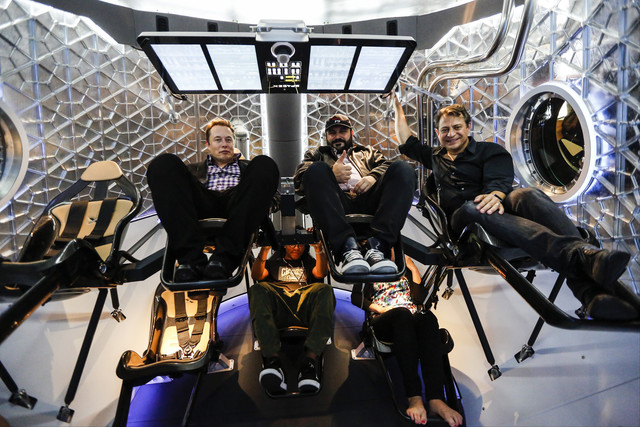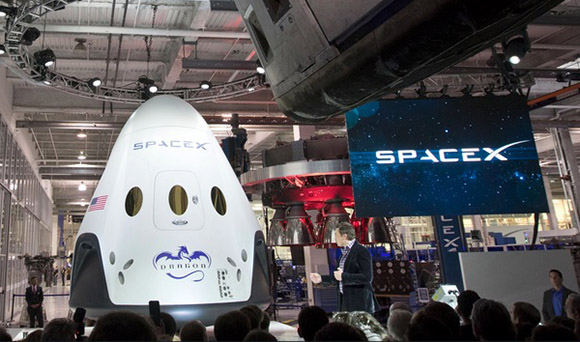World News – NASA is going back to the future with $6.8 billion in backing for Apollo-style spaceships designed by Boeing and SpaceX. Both companies have been given the go-ahead to build, test and fly their gumdrop-shaped “space taxis,” with the aim of transporting astronauts to and from the International Space Station starting in 2017.
 “Today, we’re one giant leap closer to launching our astronauts from the U.S. on American spacecraft,” NASA Administrator Charles Bolden said Tuesday from Kennedy Space Center in Florida.
“Today, we’re one giant leap closer to launching our astronauts from the U.S. on American spacecraft,” NASA Administrator Charles Bolden said Tuesday from Kennedy Space Center in Florida.
Since the retirement of the space shuttle fleet in 2011, NASA has had to rely on the Russians for rides to the station, at a cost topping $70 million per seat. Tuesday’s award is the latest phase in a years-long commercial effort aimed at fixing that situation — an effort that already has cost NASA $1 billion.
“The greatest nation on Earth should not be dependent on any other nation to get to space,” Bolden said.
Boeing will get most of the funds for its CST-100 capsule, $4.2 billion, said Kathy Lueders, the head of NASA’s commercial crew program. But SpaceX wasn’t left out in the cold: Its crew-capable Dragon capsule won $2.6 billion from the Commercial Crew Transportation Capability program, known as CCtCap for short.
SpaceX has been launching uncrewed, cargo-carrying versions of the Dragon to the station atop its Falcon 9 rocket since 2012, but the Dragon V2 craft is being upgraded with all the safety features that NASA says will be needed for carrying astronauts.
Boeing has not yet built a flightworthy model of its CST-100 craft. The company’s executives said they were relying on CCtCap funding to proceed with construction. But Boeing can draw upon decades of experience in spaceship construction — including its experience as prime contractor for the International Space Station. The CST-100 would be launched by Atlas 5 rockets from United Launch Alliance, a joint venture between Boeing and Lockheed Martin.
Both the CST-100 and the Dragon are capable of carrying up to seven astronauts, and both have a roughly conical look that’s well-suited to the kind of atmospheric re-entry and ocean splashdown that astronauts experienced at the end of each Apollo moon mission. SpaceX is working on technologies that would allow for land-based touchdowns rather than splashdowns.
‘Best choice for NASA’
A third spaceship-builder, Sierra Nevada Corp., had proposed building a mini-shuttle with wings, known as the Dream Chaser. That company received more than $300 million from NASA during earlier phases of the commercial crew program, but lost out in the final round. In an emailed statement, Sierra Nevada said it was “disappointed” not to be chosen but commended NASA for its efforts and promised further comment later.
NASA officials declined to discuss in detail why they selected Boeing and SpaceX while passing on the Dream Chaser, but said it was a close call. “This wasn’t an easy choice, but it’s the best choice for NASA and the nation,” Bolden said.
Lueders said the different amounts set aside for the two companies were based on the amounts proposed by the companies themselves.
“Both Boeing and SpaceX proposed to the same set of requirements,” she said. “NASA awarded the contracts based on their proposals. It’s two contracts to the same requirements.”
‘Lifeboat’ for the Space Station
The requirements call for the two companies to design, build, test and certify their spacecraft, climaxing with a test flight to the space station with at least one NASA crew member aboard. The companies would be paid as they complete each of five milestones over the next three years. Lueders said the contracts committed each company to fly two to six missions after certification. Each of those missions would deliver a crew of four plus cargo.
Each spacecraft would serve as an emergency “lifeboat” for the space station’s crew for up to 210 days, Lueders said.
Bolden said the payouts would be dependent on receiving adequate funding from Congress. Lueders said the 2017 time frame for flying astronauts was NASA’s goal, but not necessarily set in stone. “We will not sacrifice crew safety for that goal,” she said.
Initial reaction to the awards was positive. Rep. Lamar Smith, the Texas Republican who chairs the House Science, Space and Technology Committee, said in a statement that it was “a good day for our nation’s space program and for all Americans.” Sen. Bill Nelson, D-Fla., rejoiced as well: “We’re headed back to space and away from any reliance on the Russians,” he said in an emailed statement.
John Elbon, Boeing vice president and general manager for space exploration, said in a statement that “Boeing has been part of every American human spaceflight program, and we’re honored that NASA has chosen us to continue that legacy.”
SpaceX’s billionaire founder, Elon Musk, also said he was honored by the trust the NASA placed in his company. “It is a vital step in a journey that will ultimately take us to the stars and make humanity a multiplanet species,” Musk said.
Beyond the Space Station
At the same time that NASA is working with commercial providers on space taxis for the station, the agency is also working on its own, more capable deep-space capsule known as the Orion. The Orion is due for its first uncrewed test flight in December, and it’s expected to start carrying astronauts beyond Earth orbit in the early 2020s.
Bolden said the CST-100 and the Dragon would play essential parts in NASA’s strategy to get to Mars and its moons sometime in the 2030s. “You can’t get there if you don’t have a robust low-Earth-orbit infrastructure,” he said.
During Tuesday’s briefing, NASA astronaut Mike Fincke said he was looking forward to getting a ride on the new spacecraft. He pointed out that they should also provide “a comfortable lift for those who are not [NASA] astronauts,” including space tourists and researchers. Boeing, for instance, already has forged a deal with Bigelow Aerospace that may someday see private-sector travelers heading to non-governmental space stations aboard CST-100 capsules.
“They’re going to be terrific machines,” Fincke said.
BY ALAN BOYLE, NBCNews.com

